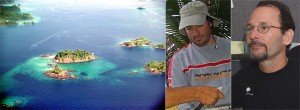 (Smithsonian Tropical Research Institute) Panamanian and US researchers participating in an innovative conservation program initiated at STRI have already discovered more than 45 compounds from CNP that show great promise against cancer, malaria and other tropical diseases
(Smithsonian Tropical Research Institute) Panamanian and US researchers participating in an innovative conservation program initiated at STRI have already discovered more than 45 compounds from CNP that show great promise against cancer, malaria and other tropical diseases
Marine creatures found nowhere else on Earth are unusually abundant in the tropical eastern Pacific Ocean. Panamanian and US researchers participating in an innovative conservation program initiated at STRI have already discovered more than 45 compounds from Coiba National Park (CNP) that show great promise against cancer, malaria and other tropical diseases.
Plants, animals and microbes continually evolve new chemical compounds to protect themselves against being eaten by each other. Sources of new compounds found in Coiba National Park include corals, sponges, plants, fungi and bacteria associated with sea urchins, tunicates and fish.
One of the best sources for new chemicals, the cyanobacteria -also known as blue-green algae- has yielded Coibamide A, a compound that is extremely active against cancer cells; Veraguamide A, an anti-cancer compound named after the Panamanian province of Veraguas; and Santacruzmate, an anti-parasitic compound named after Santa Cruz island.
At the University of Panama, a group of chemicals known as coibanoles were isolated from fungi growing inside the leaves of a plant called Desmotes incomparabilis, which is found only on Coiba Island.
The Panama International Cooperative Biodiversity Group, initiated at the Smithsonian by researchers from the University of Utah, has become a new model for international drug discovery. In the past, bioprospecting projects often left the host country out of a drug discovery process that includes collecting natural source materials, extracting chemical; testing chemicals against disease organisms in a lab, animal testing and finally drug patenting and marketing.
The ICBG program, funded by the US National Institutes of Health, the US National Science Foundation and the US Department of Agriculture, includes projects around the world to promote drug discovery, develop infrastructure, train scientists, contribute to species lists and conservation initiatives and provide favorable benefits to the host country including intellectual property rights and monetary recompense in the event that a compound is developed as a pharmaceutical drug.
The project in Panama has worked closely with the Panamanian government to establish three different local laboratories, at the University of Panama, at INDICASA T and at the Smithsonian headquarters in Panama City, and to train Panamanian scientists who staff these facilities.
US partners currently include the Smithsonian, Scripps Oceanographic Institute, the University of California-Santa Cruz, Oregon State University and the University of Connecticut. ICBG’s success would not have been possible if not for Panama’s efforts to designate Coiba as a National Park in 2004 and as a UNESCO World Heritage Site in 2005. The Smithsonian in Panama has been a thought partner in this process from the start. Staff scientist Héctor Guzmán and colleagues provided much of the information about corals and other organisms unique to the area. Marine biologist Juan Maté has coordinated the development of the new park management plan with several other local and international institutions.